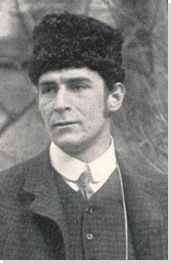Summary of Franz Marc
Although his career was cut short by his early death, Franz Marc had a tremendous impact on the various Expressionist movements that would evolve after World War I. After early experiments with Naturalism and Realism, Marc later eschewed those styles in favor of the greater symbolic potential of abstraction. He is most famous for his images of brightly colored animals, especially horses, which he used to convey profound messages about humanity, the natural world, and the fate of mankind. In association with Russian painter and theorist Wassily Kandinsky, Marc founded the group Der Blaue Reiter, which emphasized the use of abstracted forms and bold colors. Their goal was to use form and symbolism as tools to overcome what they saw as the toxic state of the modern world. As World War I approached, the tension of Marc's paintings came into especially sharp focus, as if he anticipated both his own fate and that of Europe as a whole.
Accomplishments
- Marc looked to the natural world as an antidote to modern life, from which he felt increasingly alienated. Nature and animals were more than just pleasing to him; they were spiritual and a means of relocating what had been lost in the modern era. Thus, his paintings of animals are suffused with an almost meditative reverence.
- Color was extremely important for Marc. Not only did he understand the potential for color to affect mood, he developed a specific theory of color symbolism. His analysis of color associated blue with the masculine, yellow with the feminine, and red with the physical - often violent - world.
- Marc's work embodies the heightened anxieties of early-20th-century Europe, as people struggled with a rapidly changing, urban world on the precipice of war.
Important Art by Franz Marc
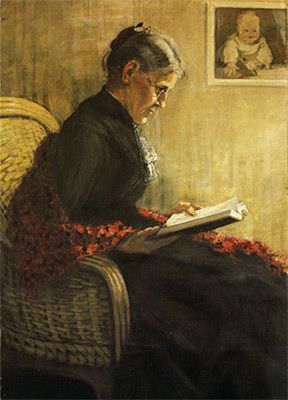
Portrait of the Artist's Mother
Painted not long after he entered the Munich Academy of Art in 1900, Marc's portrait of his mother is an excellent example of his early style, and it shows the influence of the natural realism that predominated at the academy. German realist art typically depicted the lives of ordinary people, and this painting shows Marc's mother, Sophie, as such. Painted in profile, she sits in a chair, quietly reading a book. The depiction of Sophie is intimate and quiet and suffused with an almost spiritual dignity. Stylistically, the composition is relatively flat, and makes use of muted colors, traits that were typical of natural realism. As Marc evolved as a painter, his work would move from muted to much bolder colors, and he would continue to depict shallow and flattened spaces. Yet the powerful, spiritual mood of this work also imbued his later works.
Oil on canvas - Stadtische Galerie im Lenbachhaus, Munich, Germany
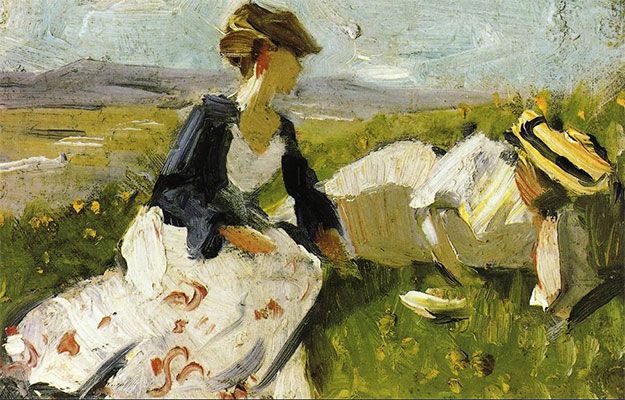
Two Women on the Hillside
After travelling to Paris in 1903, where he studied the works of the Post-Impressionists, Marc's style started to show a greater interest in color and form, with less attention paid to realism. His Two Women on the Hillside (1906) is an excellent example of this new stylistic interest. The painting depicts two fellow artists, Maria Schnur and Maria Franck, both of whom would also become his wives at different times. It is one of Marc's first attempts to depict a harmonious relationship between humans and nature, a theme that would only grow stronger over the course of his brief career. Stylistically, the work is a fascinating hybrid of the loose brush strokes and flattened space of the Post-Impressionists and the greater abstraction that artists like Marc and other German expressionists would explore in the coming years. He used expressive, linear brushstrokes to depict the bodies of the two women, and the landscape is made up only of broad bands of color that only vaguely suggest depth on the flat plane of the canvas. The repetition of lines, a style that would be prevalent in Marc's later work, is evident in the curved outlines of Maria Franck's reclining body, which are echoed by the curve of the hillside directly behind her. This is one of the most visible techniques Marc employs to draw connections between the human body and nature.
Oil on canvas - Franz Marc Museum, Kochel am See, Germany
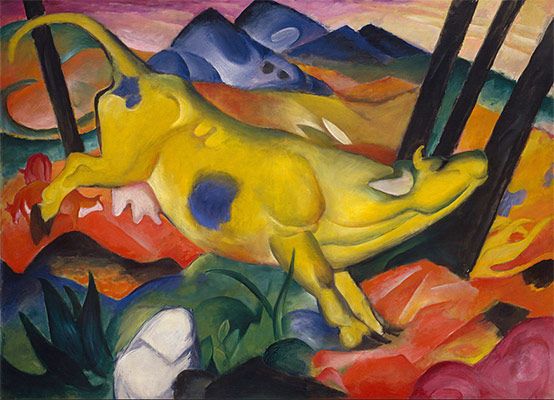
The Yellow Cow
After marrying Maria Franck in 1911, Marc painted The Yellow Cow as an homage to their union. The cow represents the safety and security Marc felt in this, his second, marriage. This composition is an early example of his use of color symbolism, a technique that had been pioneered by van Gogh, and by his friend August Macke. Van Gogh used color to represent emotion, but in his paintings identifiable features of the natural world remained. Marc built upon van Gogh's emotional use of color, by using colors to humanize natural forms in the landscape, emphasizing his own interest in pantheism. The large yellow cow represents the feminine, since Marc saw the color yellow as evoking feminine emotions. The blue spots on its hide represent the masculine, since he viewed blue as evoking masculine emotions. The combination of the two colors, then, indicates a merging of masculine and feminine, in a reference to his marriage to Franck. His repetition of color connects the animals with their background. This is most evident in the small herd of red cows grouped together at the left of the composition; they are camouflaged, blending into the rocky, red landscape around them. Marc also uses color and line repetition with the large yellow cow. The cow dominates the foreground of the dreamlike composition, exuding a mood of blissful serenity as it leaps over the rocky landscape in the foreground. The blue hills in the background echo the shape of the cow's haunches. The repetition of color and line throughout reverberate with a sense of energy as well as safety and happiness.
Oil on canvas - The Solomon R. Guggenheim Museum, New York, New York
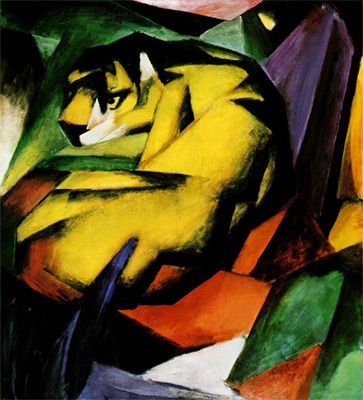
Tiger
The calm, dreamlike world of The Yellow Cow, is here replaced with a restless tension. The tiger, whose bodily strength is represented with intersecting shards of color and acute angles, is tightly contained within the bold, black outline. The surrounding space is similarly electrified. Marc depicts the tiger in a moment just before attack; it is ready to break out of whatever is restraining it. There is a sense of a violent threat. The calmness and security of his earlier work is altogether absent in this work. Marc's use of Cubist techniques allowed him to create the unmistakable feeling of tension without changing his approach to either color or subject matter. Still, his interest in the greater abstraction of the Cubists marks a distinct artistic departure. Even during such experimentation, Marc never wavered from his interest in bold, primary colors and their potential to convey emotion.
Oil on canvas - Stadtische Galerie im Lenbachhaus, Munich, Germany
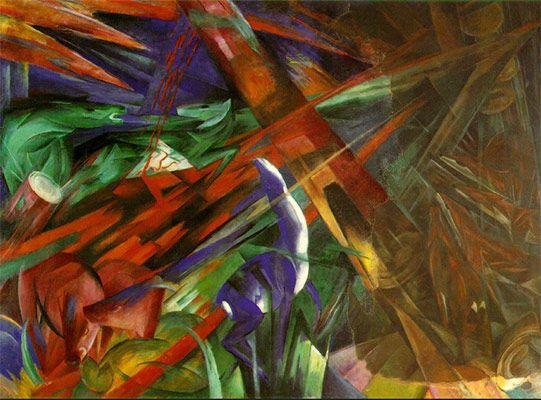
Fate of the Animals
The Fate of the Animals is a vision of annihilation as seen through the eyes of the animals. The sharp angles and jagged shapes of the composition convey Marc's more jaded view of the relationship between man and nature. The image serves as a premonition of the horrors of war. Indeed, Marc shows the world being utterly ripped apart. Fantasy is still an important feature in this work, but in this case the fantasy has turned dark and foreboding. Fires rain down from above and fallen trees jut out of the still hot embers of the underbrush. All of the animals are panicked, their faces and bodies contorted to express the terror of trying to escape their inescapable demise. Ultimately, this is an apocalyptic vision of the looming war. Despite the chaos and destruction of the work, Marc manages to create a balanced and ordered composition. A blue deer, symbolizing hope, stands in the center foreground, twisting away from the falling tree that threatens to crush it. That Marc chose to place this symbol of hope in the center foreground of the composition, suggests that he himself had a hopeful vision of the future. What's more, the fact that Marc borrowed from the Futurists in his painting style suggests that he had a positive view of the destruction he depicted. Since destruction was a necessary step before society could be rebuilt, this powerful image could be read as not only tragedy and decimation, but as progress.
Oil on canvas - Kunstmuseum Basel, Basel, Switzerland

The Tower of Blue Horses
This painting is another example of Marc's apocalyptic fears. Here, he depicts four blue horses, possibly representing the Four Horsemen of the Apocalypse from the book of Revelation. The horses are stacked one above the other, on an ascending, vertical plane, eschewing depth altogether. The stacking of the horses on top of one another also allowed Marc to repeat lines and shapes, which was a hallmark of his style. The composition is grounded by a vertical line that runs at a diagonal from the right foreleg of the horse in the foreground up to the sky, which the line separates into two distinct areas of yellow and blue. The strong vertical line enhances the verticality of the composition, in which the horses appear to be stacked on top of one another rather than receding back into space and in which the rocky landscape at the left is similarly stacked. The lack of depth in favor of a vertical arrangement adds to the already tense mood of the painting. As if this weren't enough, Marc adorns the chest of the foreground horse with a crescent moon - a symbol commonly used by the German Expressionists to represent their longing for the apocalypse, which would provide a chance for the world to cleanse itself and start anew. These Expressionists saw the coming war as an opportunity for positive change. This perhaps explains Marc's use of the color blue, which symbolized hope, in the image. For him the apocalypse was not just about destruction so much as the promise of a new world.
Oil on canvas - Missing since 1945

Broken Forms
Broken Forms is one of Marc's final works and showcases his ultimate move away from representation in painting. After becoming increasingly disillusioned with nature and animals - seeing them as tainted and impure as human beings - Marc sought solace and meaning in the symbolism of color and abstract form. Although this is a break from his earlier direction, Marc's strong interest in color is still evident in this work, and his signature blues, yellows, and reds, are highlighted. It also reveals Marc's continued interest in representing emotions, especially as they relate to the anxiety of the coming war. The painting is one of a series of four that Marc painted in 1914, the other three works being Cheerful Forms (now destroyed), Playing Forms, and Forms in Combat. While representational forms can be interpreted from these works, especially with the help of their titles, they are ultimately free from earthly narrative, allowing Marc to depict the spiritual world he had so long sought to represent via animals in his earlier paintings.
Oil on canvas - Guggenheim Museum, New York
Biography of Franz Marc
Childhood and Education
Franz Marc was born in Munich, Germany on February 8, 1880. His father, Wilhelm Marc, was an amateur landscape painter. Under the influence of his artistic father, Marc's artistic talent was evident from a young age, but he did not decide to pursue a career in painting until after completing his military service.
In 1900, Marc enrolled in the Munich Academy of Art, but the curriculum's focus on natural realism left him dissatisfied. While enrolled at the academy, he became acquainted with the Jugendstil art movement, whose popular decorative motifs emphasized the use of expressive line to depict natural forms and structures. The Jugendstil artists inspired Marc to break free of the strict confines of naturalism taught in the academy. Marc's earliest paintings from this period (dating to around 1902) suggest a young artist experimenting with new styles that were at odds with the styles espoused by the academy. The most notable feature of these early paintings is their bold, expressive color. They also feature flat, two dimensional backgrounds, which echo the style of the Jugendstil artists.
Early Period
In 1903, Marc spent six months in Paris studying modern and Impressionist paintings. At that time he met the French artist, Jean Niestle, who was famous for painting animals. Niestle's animals were depicted with the same soft, expressive lines found in Japanese woodblock prints. Perhaps due to Niestle's influence, Marc started to depict animals in his own paintings as early as 1905. He returned to Paris in 1907, on the eve of his ill-fated first marriage, "to calm his anguished and vacillating soul in van Gogh's wonderful pictures." In the years that followed he experimented with Impressionism and Pointillism, but found them unsatisfactory for his own work. This was partially based on his interest in color; he desired a palette that would echo the rhythm of his expressive linear forms. Ultimately, Marc turned to the Fauves, who appealed to him for a number of reasons. Not only did they use vibrant and distorted colors, but they also sought to record primitive life and to depict the relationship between man and nature, a goal that would become ever more important to Marc as well.
However, Marc's paintings still retained the moody, representational forms that were favored in academic naturalism. Upon his return to Munich, he threw himself into the study of the anatomy of animals. Later, when living in Berlin, he spent countless hours at the Berlin Zoo studying and sketching the forms of animals from every conceivable angle. Through rigorous and disciplined study, he created a general concept of animal and human forms. The image of the animal continued to become ever more prominent in his art, almost replacing the human form entirely. For Marc, animals were the ideal subject matter for depicting truth, purity, and beauty. He said, "on the whole, instinct has never failed to guide me . . . especially the instinct which led me away from man's awareness of life and towards that of a 'pure' animal. . . . an animal's unadulterated awareness of life made me respond with everything that was good." Marc's animals served as reflections of nature, imitating the regularity with which certain forms occur in nature.
Mature Period
During the years 1908 and 1909, Marc began to combine his newfound interest in anatomy with the intense, symbolic color palette of the Fauves. Like them, Marc felt that the dream was the truest expression of reality. He believed that every fantasy was based in fact. The biggest turning point in his career and personal life came in 1910, when Marc became friends with the artist August Macke. The two men developed a friendship that involved travel and study - a true friendship of equals. Around this time, Marc found himself keeping company with other like-minded, painters, including Wassily Kandinsky.
Kandinsky, was a founding member of the Munich Neue Kunstler Vereinigung (NKVM), (Munich New Artists Federation) - a group that believed in an analytical spiritual mysticism. His paintings sought to elicit a similar emotional effect as listening to music. He even went as far as to refer to his paintings as "compositions." Macke, though younger than Marc, had already achieved some success in employing color in his paintings to express conflict and harmony. Under the influence of Macke, Marc began to experiment with a color theory of his own, one that would best depict the emotional intensity of his subject matter. By late 1910, he had developed his color theory in which: "Blue is the male principle, astringent and spiritual. Yellow is the female principle, gentle, happy and sensual. Red is matter, brutal and heavy and always the color to be opposed and overcome by the other two."
The NKVM disbanded in 1910 due to mounting artistic tensions. As if to fill the void left by NKVM, Marc and Kandinsky co-founded Der Blaue Reiter (The Blue Rider) in 1911. Der Blaue Reiter and Die Brücke (The Bridge) were the two main branches of German Expressionism. The members of Die Brucke were united by a common artistic style, particularly a preference for bold colors and simplified, flattened forms. The Blue Rider artists, however, were instead unified by a common ideology, of creative freedom for artists to express their personal vision in whatever manner they deemed appropriate. Both groups were interested in depicting nature and the universe as a means of self-expression, not unlike the Romantic artists of the previous century. The symbolic and psychological function of color was an integral part of Der Blaue Reiter's program. Marc's own belief system revolved around pantheism, and his work repeatedly depicts nature as if seen through the eyes of an animal or other "primal" figure.
In 1912, he met the French artist Robert Delaunay, whose dynamic Cubist style was already well known among the Der Blaue Reiter artists. Marc's artworks, which up to this point were still very representational in form, started to become noticeably more Cubist. Under Delaunay's influence he began to experiment with simultaneous color contrast, which created an effect that resembled the early works of Picasso and Braque. His painting Tiger (1912) showcases this well.
Late Period
By 1913, Marc's work, like that of his contemporaries, became increasingly apocalyptic. Along with this shift came a change in how Marc viewed animals. In fact, he began to see animals as almost as impure as human beings. He wrote, "from one year to the next, trees, flowers, the earth, everything showed me more and more ugly and repulsive sides, and it was not until now that I became aware of the hideousness of nature and its impurity." His tense and conflicted feelings are evident in his paintings from that year, including Fate of the Animals, Tyrol, and The Tower of Blue Horses. In spite of the tension in these paintings, Marc believed that the war would be a purifying force that would rid the world of all that was evil and putrid. Through the ritualistic cleansing of war, he believed the world, especially the natural world, would regenerate.
By the following year, 1914, World War I had broken out, and Marc's work moved towards complete abstraction. That year, he worked on a series of four abstract paintings, Cheerful Forms, Playing Forms, Forms in Combat, and Broken Forms, that showcased his final move away from representational painting toward works that were completely dedicated to form. Later that year, Marc enthusiastically enlisted in the German Army as a cavalryman. Writing to Kandinsky, he said of the war, "this is the only way of cleaning out the Augean stable of Europe." Indeed, Marc was so enthusiastic that he asked, "Is there a single person who does not wish this war might happen?" His good friend Macke also enlisted in 1914, and died in combat later that year, devastating Marc. Marc himself was killed in action at the Battle of Verdun on March 4, 1916.
The Legacy of Franz Marc
As a leading figure in the German Expressionist movement, Marc helped redefine the nature of art. The Expressionist movement was known for of its interest in spirituality and primitivism, and its use of abstraction. Marc incorporated his love of theology and animals into his work to create an alternate, more spiritual, vision of the world. He depicted the world as seen through the eyes of animals, who he used to highlight those aspects of modernity that he viewed unfavorably. But his later work also moved beyond representational forms into pure abstraction, leading the way for the next generation of painters.
Though his career was brief, his expressive linear forms and symbolic use of color had a lasting impact on the worlds of abstraction and expressionism. Indeed, artists such as Jackson Pollock and Willem de Kooning can be called Marc's descendants. These artists were inspired by Marc's ability to generate a sense of emotion with his interest in the spiritual and the primitive, as well as his use of bright colors. The Abstract Expressionists built upon Marc's contributions by creating paintings that emphasized more minimal, generalized forms that focused primarily on linear expression and color. These new approaches to Expressionism sought to highlight the artists' personal struggles with the changes that came after the end of World War II. Later generations of expressionists, such as Color Field artists who took expressionism to its most minimalist, simplified state, can be viewed as descendants of Marc and his contemporaries. Indeed, Franz Marc, as a founding member of German Expressionism, was instrumental in helping to define modernism in the 20th century and beyond.
Influences and Connections

-
![August Macke]() August Macke
August Macke ![Albert Bloch]() Albert Bloch
Albert Bloch
Useful Resources on Franz Marc
- Franz Marc (Mega Square)By Victoria Charles
- The Essential Encyclopedic Guide to Modern Art: Styles, Schools and MovementsBy Amy Dempsey
- The Apocalyptic Vision: The Art of Franz Marc as German ExpressionismOur PickBy Frederick Levine
- The German Expressionists: A Generation in RevoltOur PickBy Bernard S. Myers
- Franz MarcBy Susanna Partsch
- Modern German PaintingOur PickBy Hans Konrad Roethel
- Franz Marc (Art and Design)By Mark Rosenthal
- German Expressionist PaintingOur PickBy Peter Selz
